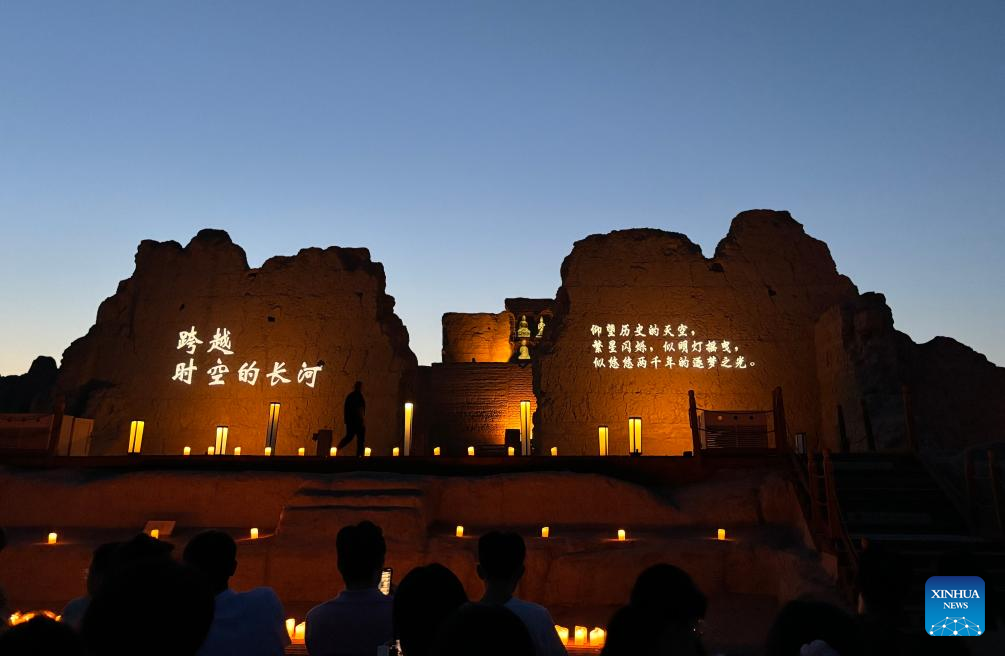


This photo taken by a mobile phone shows people watching a concert during a night tour at the Jiaohe Ruins in Turpan, northwest China's Xinjiang Uygur Autonomous Region, on Aug. 23, 2025. (Xinhua/Lyu Qiuping)
URUMQI, Sept. 17 (Xinhua) -- In the heart of Urumqi, capital of northwest China's Xinjiang Uygur Autonomous Region, a theater complex brings the ancient Silk Road to life with eight immersive shows that draw audiences into the very stories of the past.
Named "The Silk Road Has a Show," the project showcases stories spanning from the lost civilization of Loulan to the art of the ancient Qiuci State. Blending immersive sets with interactive audio-visual technology, it allows visitors to experience the vibrant multicultural exchanges up to some 2,000 years ago.
Covering 31,600 square meters, the complex also includes shopping and dining areas where visitors can sample Xinjiang-style snacks and purchase local commodities, including traditional musical instruments.
"We want the audiences to step into the story and witness firsthand the prosperity and ethnic fusion of the ancient Silk Road," said Ma Bo, the chief director of the shows.
The Silk Road, named after the lucrative trade in Chinese silk along the route, has been a vital corridor between East and West for two millennia, with Xinjiang lying at its heart.
By tapping into this rich cultural heritage, Xinjiang is not only preserving history but also fueling a new growth model through the integration of culture and tourism. This approach has boosted local employment, expanded business opportunities, and created a sustainable economic engine for the region.
Buayxam Abduwayit, a dance graduate from the city of Kashgar, now works as a performer at the theater, earning 6,000 yuan (about 845 U.S. dollars) per month.
"The salary is much higher than what I earned at my previous job with a troupe in my hometown, Kashgar's Shufu County," she said, adding that her fellow dancers, around 30 in total, include both locals and people from other provinces.
Since its opening in January this year, the theater has welcomed over 300,000 visitors. The block as a whole, including the neighboring commercial streets, has helped create some 1,000 jobs.
Zhang Lei, manager of the theater project, said that since outdoor tourism slows down in winter due to the climate, the indoor theater is a perfect place to visit in winter, as well as in the scorching summer.
Taking advantage of a visa-free policy, Uzbek businessman Uktam Buriyev, 30, joined a 10-day group tour across Xinjiang, visiting cities including Turpan and Urumqi.
He called the shows "beautiful" and, more importantly, saw a new business opportunity during his tour. "I plan to return next month to purchase clothing to sell in Uzbekistan," he said.
In 2024, Xinjiang's tourism revenue jumped 21 percent to over 359 billion yuan as the region welcomed 300 million visitors, and in 2025, it expects to receive 320 million tourists.
In Turpan, a former Silk Road hub and renowned grape-growing base, the Jiaohe Ruins, a world cultural heritage site and also the best-preserved, longest-lasting and largest relics of a clay-built city across the globe, have opened night tours.
Under the moonlight glow, tourists can wander through the ruins and enjoy a concert featuring traditional folk musical instruments.
"The soul-stirring melodies and the soft light of the ancient city at dusk evoke vivid images of the Silk Road's glory," said Liu Renjian, a tourist from Beijing.
To attract more tourists, since last year, Turpan's A-grade attractions have offered free re-entry for visitors after their first real-name ticket purchase.
Boosted by the policy, the city attracted 22.79 million tourists in the first seven months of this year, generating 17.38 billion yuan in revenue, up 25.6 percent and 22.32 percent year on year, respectively.
Zhang Guobi, a local tourism official, said Turpan is moving beyond ticket sales toward a broader tourism-driven economy, with events such as the Jiaohe marathon and the grape festival already held or set to become regular fixtures.
"These activities will reinforce our identity as both a historic pearl on the Silk Road and a modern capital of grapes," Zhang added. ■

This photo taken by a mobile phone shows people watching a show at a theater complex named "The Silk Road Has a Show" in Urumqi, northwest China's Xinjiang Uygur Autonomous Region, on Sept. 8, 2025. (Xinhua/Lyu Qiuping)
点击右上角![]() 微信好友
微信好友
 朋友圈
朋友圈

请使用浏览器分享功能进行分享
